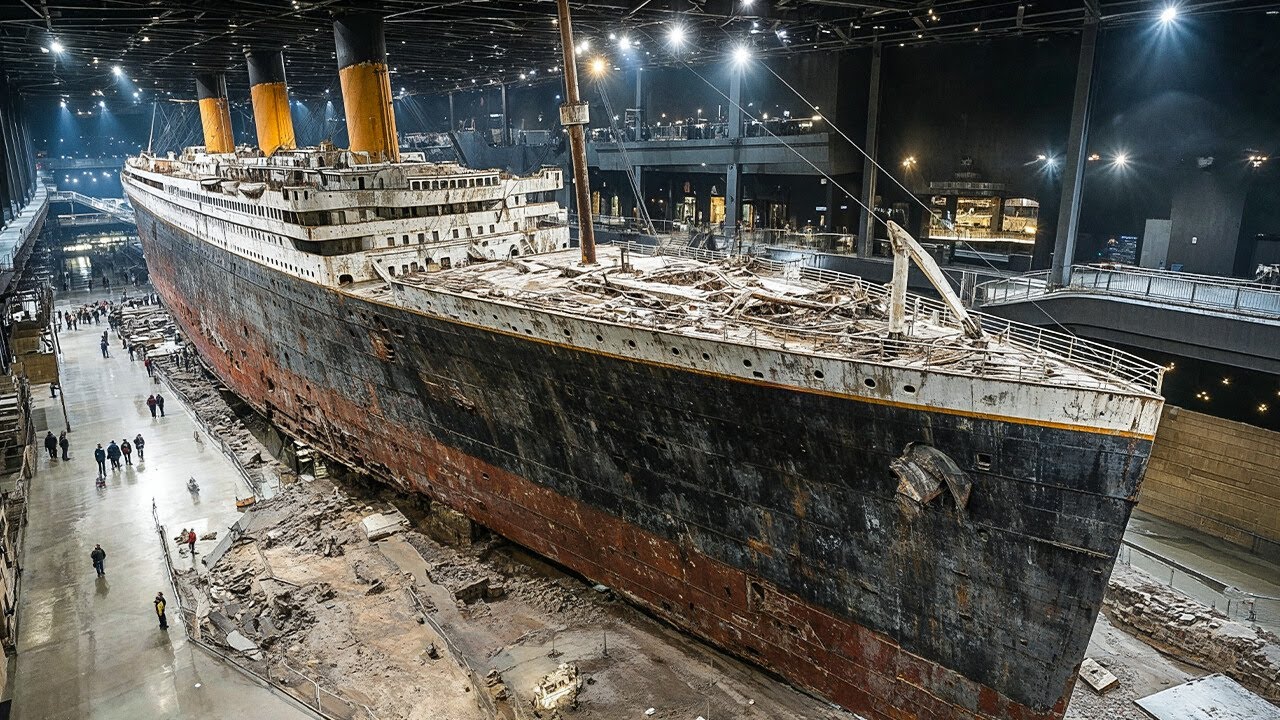🚢 MYSTERY UNVEILED: The Titanic lies 12,500 feet below the ocean, but a chilling truth about why we’ll never raise it will leave you stunned! 😱 Beyond the romance of lost treasures and heroic tales, something haunting lurks in the deep—secrets the sea refuses to surrender. Could it be more than just rust and time keeping her down?
Click to discover the shocking reasons that’ll change how you see this legendary ship forever!

The RMS Titanic, the “unsinkable” ship that sank on April 15, 1912, remains one of history’s most enduring tragedies. Lying 12,500 feet beneath the North Atlantic, approximately 370 miles southeast of Newfoundland, the wreck has captivated imaginations for over a century. Countless dreamers—from adventurers to filmmakers—have fantasized about raising the Titanic, restoring it to its former glory, or at least salvaging its treasures. Yet, despite technological advancements, the consensus among experts is clear: the Titanic will never be raised. The reasons, far from mundane, are a blend of logistical nightmares, ethical dilemmas, and natural forces that have shocked researchers and historians alike. This article delves into the multifaceted barriers—technical, ethical, and environmental—that ensure the Titanic remains an untouchable relic, drawing on scientific studies, legal frameworks, and firsthand accounts.
The Titanic’s Physical State: A Fragile Relic
When oceanographer Robert Ballard located the Titanic in 1985, the world was stunned to learn it had split into two main pieces—a bow and stern roughly 2,000 feet apart—surrounded by a vast debris field. The bow, though recognizable, is heavily damaged from its collision with the seafloor, while the stern is a crumpled wreck, imploded during its descent. Over a century in the deep ocean’s high-pressure, low-oxygen environment has left the ship’s steel structure brittle and deteriorating.
A rust-eating bacterium, Halomonas titanicae, discovered on the wreck, is consuming the iron, forming fragile rusticles—stalactite-like structures that crumble to dust when disturbed. By 2019, comparisons of images from 1996 showed significant decay, with iconic features like Captain Edward Smith’s bathtub gone as the deck collapsed. Experts estimate the wreck could disintegrate entirely within decades, making any attempt to lift it likely to cause catastrophic disintegration. The ship’s steel, described as “too brittle for even the most industrious crane operation,” is further trapped in deep-sea sediment, acting like quicksand.
The 1998 salvage of a 15-ton hull section, known as the “big piece,” illustrates the challenge. It took two attempts (1996 and 1998) to raise this relatively small fragment, which required careful transport in water to slow corrosion and 20 months of chemical treatment to stabilize it. Scaling this to the entire ship—882 feet long, weighing 52,310 tons, and broken into two major sections—would be technologically unfeasible with current capabilities. The extreme pressure at 12,500 feet, 370 times greater than at sea level, complicates operations, as demonstrated by a styrofoam cup crushed to a fraction of its size in a Titanic dive.
Logistical and Financial Barriers
Even if technology could overcome the wreck’s fragility, the logistics are staggering. Raising the Titanic would require equipment far beyond today’s capabilities. Proposals from the past, like using cranes or balloons, have been dismissed as impractical. For instance, a 1970s scheme to fill the ship with ping-pong balls was abandoned when calculations showed the balls would crush under deep-sea pressure. Another idea, encasing the ship in ice using liquid nitrogen, was deemed absurd due to the need for half a million tons of coolant—an operation costing billions.
Modern salvage would demand specialized submersibles, massive cranes, and custom-built vessels, with costs estimated in the tens of billions of dollars. The 1980 film Raise the Titanic, based on Clive Cussler’s novel, famously cost $40 million—prompting producer Lew Grade to quip, “It would have been cheaper to lower the Atlantic.” In reality, the financial burden would dwarf this, with no guarantee of success. The 1996 attempt to raise an 11-ton hull section failed when balloons broke free, sending it back to the seabed, highlighting the unpredictability of such endeavors.
Moreover, the wreck’s location in international waters complicates matters. While RMS Titanic Inc. holds salvage rights, any large-scale operation would require coordination with multiple nations, navigating complex maritime laws. The U.S. and U.K. have agreed to treat the site as a memorial, limiting invasive actions, and courts have blocked efforts to cut into the hull, as seen in a 2020 legal battle over retrieving the Marconi radio.
Ethical and Cultural Considerations
Perhaps the most compelling reason not to raise the Titanic is ethical. The ship is the final resting place of over 1,500 souls, with approximately 1,635 deaths in the disaster. Only 328 bodies were recovered, 119 buried at sea, and 209 brought to Halifax, Nova Scotia. Many victims likely remain within the wreck or its debris field, preserved by the cold, low-oxygen environment. Disturbing the site risks desecrating what is widely considered a maritime grave.
The U.S. and U.K. formalized this view through the Agreement Concerning the Shipwrecked Vessel R.M.S. Titanic, designating the site a memorial under the Archaeological Resources Protection Act. NOAA, representing U.S. interests, supports preservation over salvage, arguing that entering the hull or altering the wreck violates international agreements. In 2020, RMS Titanic Inc.’s plan to retrieve the Marconi radio sparked outrage, with opponents citing potential disturbance of human remains, though some experts believe saltwater and marine life have decomposed most organic material.
Archaeologists argue that the Titanic’s value lies in its context on the seafloor. Removing it would strip away historical insights gained from studying the wreck in situ. Over 5,500 artifacts, from jewelry to a section of the hull, have been recovered from the debris field and displayed in museums worldwide, preserving the ship’s legacy without disturbing its core. For many, like survivor Edith Brown Haisman, who was reunited with her father’s pocket watch in 1991, these artifacts provide a tangible connection to the past without violating the site’s sanctity.
Environmental and Scientific Factors
The deep ocean is not a lifeless void but a vibrant ecosystem. The Titanic hosts 28 species, including sea anemones, crabs, and a unique sea cucumber with phosphorescent “portholes.” Raising the wreck would disrupt this biodiversity, which rivals tropical rainforests. The discovery of Halomonas titanicae has advanced scientific understanding of bio-deterioration, offering insights into microbial processes that could inform conservation or even medical research.
The wreck’s decay also serves as a natural archive. Its rusticles and corrosion patterns reveal how materials behave under extreme conditions, aiding studies in materials science and marine archaeology. Moving the ship would destroy this living laboratory, which continues to yield data through expeditions like RMS Titanic Inc.’s 2024 high-resolution imaging mission.
Historical Attempts and Cultural Fascination
Since 1912, schemes to raise the Titanic have ranged from plausible to absurd. Early plans by families of wealthy victims like John Jacob Astor proposed dynamiting the wreck to recover bodies, abandoned when scientists noted the bodies were likely pulverized (a claim later disproved). A 1914 proposal to use electromagnets and a 1960s plan for gas-filled balloons failed due to cost and technical limitations. These efforts reflect a cultural obsession, fueled by films like Titanic (1997) and Raise the Titanic (1980), which romanticized the idea of resurrecting the ship.
The 1985 discovery by Ballard shifted focus to preservation. His team’s haunting images revealed a ship both majestic and fragile, prompting a reevaluation of salvage ethics. Subsequent expeditions, like the 2023 digital twin by Magellan Ltd., mapped the wreck in unprecedented detail, proving that non-invasive study is more feasible and respectful.
Critical Perspective on the Narrative
The claim that “we’ll never raise the Titanic” can feel sensationalized, as technological barriers may one day be overcome. A 2007 forum post on Encyclopedia Titanica argued that future advancements could make it feasible, citing humanity’s history of defying the impossible, like deep-sea submersibles. However, this optimism overlooks the ethical and ecological arguments, which carry greater weight today. The “shocking” element often lies in media exaggeration—such as claims of hidden treasures or conspiracies—when the reality is a sobering mix of physics, morality, and law.
Conclusion
The Titanic will never be raised due to a confluence of insurmountable challenges. Its fragile state, battered by rusticles and pressure, defies current technology. The astronomical costs and legal restrictions in international waters make the endeavor impractical. Most crucially, its status as a grave for over 1,500 victims demands respect, supported by U.S.-U.K. agreements and archaeological consensus. The wreck’s scientific value as a marine ecosystem and historical archive further cements its place on the seafloor. Far from a lost opportunity, leaving the Titanic undisturbed preserves its legacy, allowing future generations to study and honor it through artifacts and imaging. The shocking truth isn’t a hidden secret but a profound reminder: some histories are meant to rest in peace.





